Pick
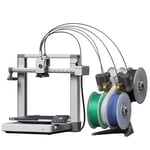

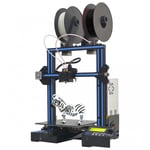
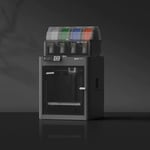
Dual extrusion (or multi extrusion) 3D printing is many things to many makers. To some, it’s the possibility of printing multicolor objects, cutting down on post-processing and finishing work after a part has been printed. For others, it’s a means to achieve more complex prints using soluble or breakaway support material – something not possible using a typical single extruder 3D printer.
Another reason could be productivity, with independent dual extrusion (IDEX) machines offering the ability to print two identical models simultaneously. This particular reason is a bit of a gimmick in the consumer space if you ask us – two single-extrusion machines will be eminently more productive than a single IDEX, and you halve the risk to your prints should one model fail.
Handily, we go hands-on with the printers worth knowing about and have the answer to which are the best dual extruder 3D printers to buy right now. Note we’re focused on consumer-grade machines in this guide; for pro options, jump over to our guide to The Best Independent Dual Extruder (IDEX) 3D Printers.
The considerations for dual extrusion 3D printers aren’t particularly complex. Ultimately, it’s all about the type of 3D print you want to achieve and how cleanly the printer can accomplish it. That’s about it.
The style of the extrusion system will play a large role in how well the printer can achieve this. Two extruders feeding material to a single nozzle risks cross-contamination of the materials and will require more rigorous purging of the nozzle for clean prints. An IDEX 3D printer, conversely, uses entirely separate print heads for each material, minimizing contamination at the expense of added complexity to the motion system and calibration – physical or software offsets may be needed to get the print heads printing in alignment.
There are also dual-nozzle printers that have a single printhead but two nozzles that extrude independently. These are a bit more flexible and can produce faster multi-material prints; faster because less time is spent switching filaments and more versatile because the separate nozzles allow printing with varying nozzle diameters in a single print. Dual-nozzle printers do add the risk of oozing filament from the inactive nozzle affecting your print, though, so you’ll likely need to print an ooze shield and prime tower.
It’s a push-pull of factors, and as we’ve seen in recent times, no one system is necessarily superior to another, just specific printers and what they offer for their price point and feature set. We’re increasingly seeing multi-material addons pulling focus from dedicated dual extrusion setups, giving greater material choice and versatility as an added bonus to stable, high-performance single extrusion 3D printers, but at the cost of wasting material with notably excessive purging.
When selecting a multi-extrusion 3D printer, think about what you want to accomplish. If you’re just looking to print in multiple colors, a single-nozzle system is likely the most affordable and will keep upkeep to a minimum. If you want to print with soluble supports or different nozzle sizes, you might want to consider a dual-nozzle printer.
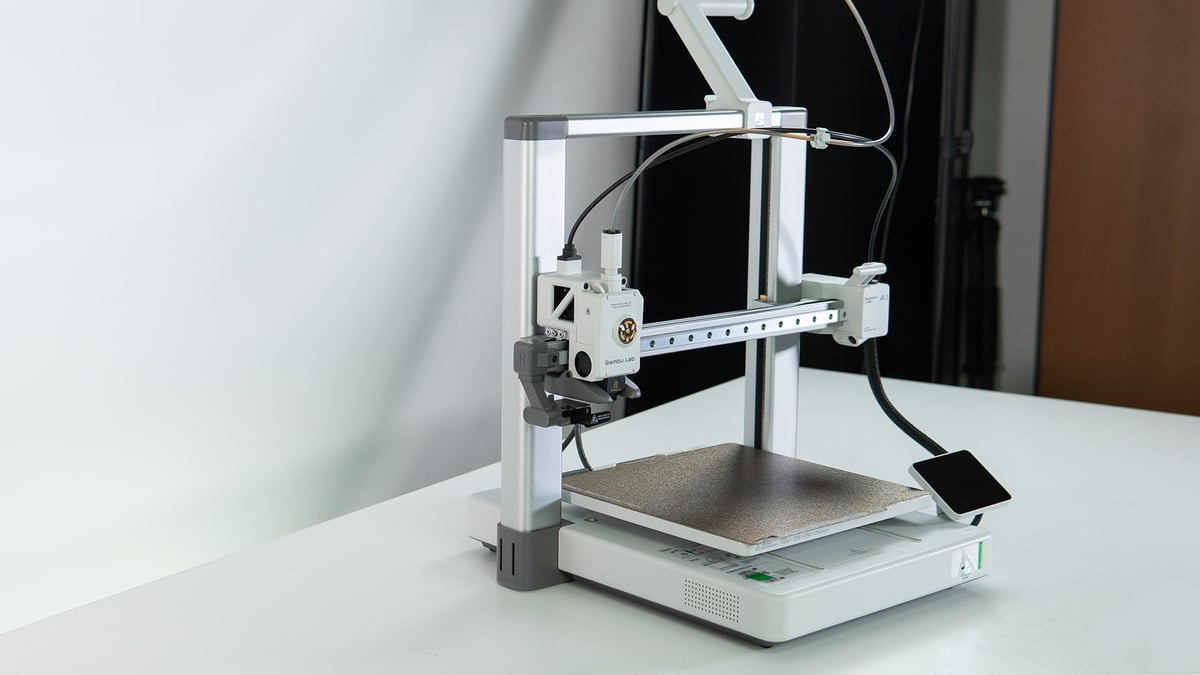
Editor's Note: The Bambu Lab A1 3D printer is temporarily unavailable following a recall action by Bambu Lab. Hit the link to read more.
Bambu Lab was already a staple of multi-material 3D printing with the CoreXY 3D printers and Automatic Material System (AMS) that launched the company into success, and that’s reflected in our upgrade pick here. But more recently the OEM released its A1 series of bedslinger 3D printers that are compatible with its new AMS lite – and are much more affordable than their counterparts.
The A1 is an excellent Cartesian XZ-head 3D printer in its own right that’s pretty affordable at $399. It boasts a 256 x 256 x 256 mm build volume, just like Bambu Lab’s CoreXY systems, a linear rail across its X-axis for steady and smooth print head motion and discreet linear rods on all other axes, automatic bed leveling and offsets along with a host of other calibration automation that includes noise reduction, a toollessly replaceable hot end, and the same seamless software experience that made us fast fans of Bambu Lab. Combined with the AMS lite, it’s a four-filament powerhouse for $559.
Like the full-fledged AMS, purging between material changes can be considered excessive. Though that’s one of the reasons the system works as well as it does, it can certainly feel wasteful. There are some more sacrifices when picking the AMS lite over the standard version, too. For one, there are no enclosures for either the printer or the AMS lite, and you’re limited to just four filaments – unlike the full AMS’ extendability to a whopping 16 materials. And, unfortunately, there’s no upgrading later. The A1 series isn’t compatible with the standard AMS.
Still, preparing multi-material prints is trivial with the slicer, Bambu Studio’s, material painting feature that means multi-part files aren’t strictly necessary, and the Bambu Handy app is an excellent mobile companion. It’s a great way to get into Bambu Lab’s feature-rich ecosystem on a tighter budget than its flagship systems allow.
If the price is a little too steep for you, you can save $100 by opting for the A1 Mini so long as you’re willing to sacrifice some build volume. It’s a 180 x 180 x 180 mm cantilever version of the machine that provides a very comparable experience.

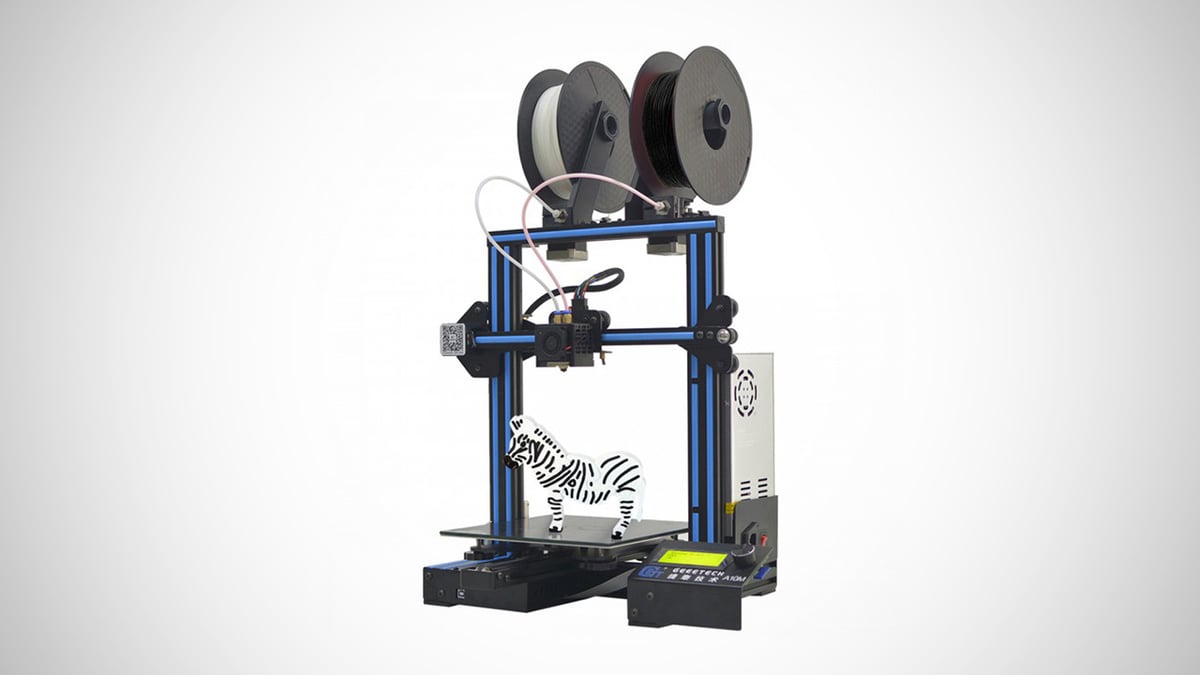
Piggybacking on a design popularized by Creality’s Ender 3, the Geeetech A10M plonks a cherry on top of that particular cake by adding dual extrusion.
Indeed, thanks to two extruders piping filament into the A10 M’s two-in-one-out hot end, this 3D printer offers four printing modes: single color, dual color, graded color, and mixed color. You can lay down two different colors in succession (obviously) or use Geeetech’s Color Mixer software to blend different colors to make new hues and gradients.
It has a 220 x 220 x 260 mm build volume, which isn’t too shabby for a dual extrusion 3D printer that can be picked up for less than the 3D printer it’s based off of. And, with an open-source control board, the printer allows for additional upgrades such as auto-leveling or a Wi-Fi module.
The cheapest dual extrusion printer on this list by far, the Geeetech A10M is a low-risk entry point to multicolor 3D printing.
We can’t say the Geeetech A10M is necessarily a good fit for a complete beginner to 3D printing. While its manual is detailed and helpful, the printer offers only a basic user experience and the possibility of a frustrating learning curve compared to the other printers in this guide. Still, if you’re keen to try your hand at multi-color printing and don’t want to shell out for the premium systems, it’s a good option with some unique features like color mixing.

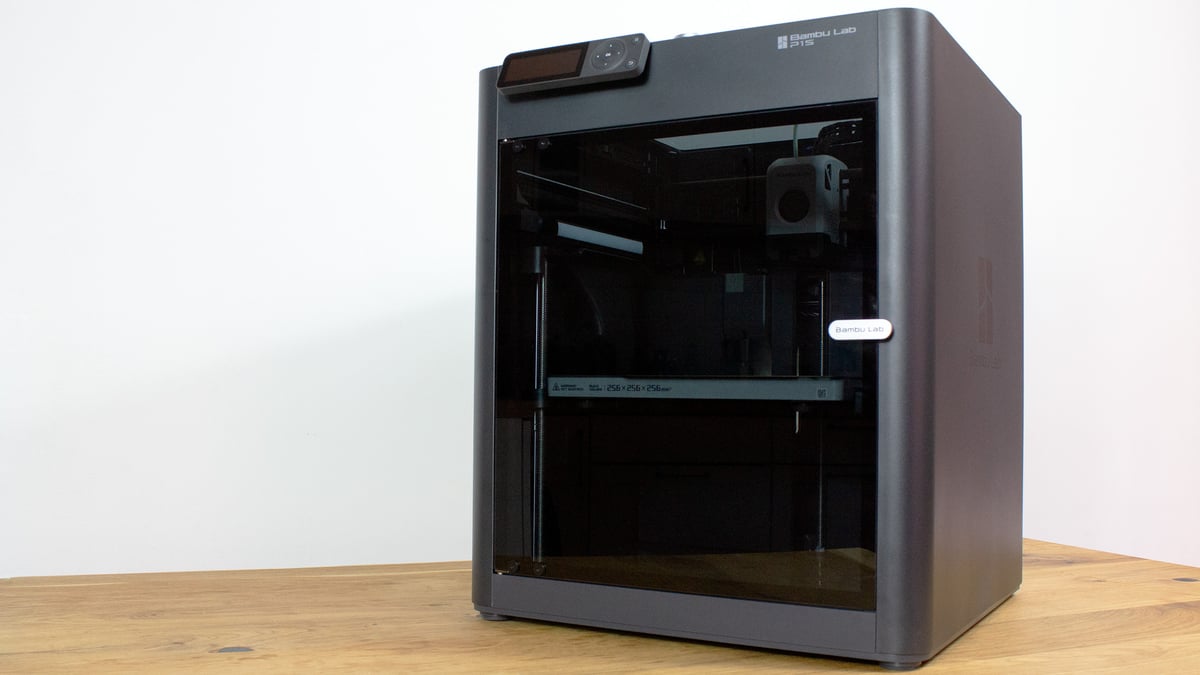
The Bambu Lab P1S is the enclosed successor to the company’s budget-conscious P1P, and, in a combo with the AMS, it’s priced to match the P1P too. This single-extrusion 3D printer is built for speed, outputting high-quality prints in a fraction of the time of most other printers on the market.
Alone, it is not a dual extrusion 3D printer. But, in combination with Bambu Lab’s Automatic Material System (AMS), a standalone box that houses four spools of filament and connects to its 3D printers, the P1S can use four spools in a single print – supercharging the printer’s abilities and making it a truly versatile multicolor (or multi-material) machine.
The P1S 3D printer alone will set you back $699. This gets you a 256 x 256 x 256 mm enclosed build volume and a print system with a direct extruder and hot end that heats to 300 °C. The AMS is a further ~$350, but you can shave $100 off the price by buying the two together for ~$950. It’s also possible to chain four AMS units together to create prints using 16 (that’s not a typo – 16) filaments in total.
Expect a smart, interconnected experience from the P1S. With a few added benefits, it’s functionally the same machine as the P1P, which, as of the beginning of 2023, has been our upgrade recommendation for beginners. The machines benefit from solid software and user experience underpinned by a PrusaSlicer-based slicer and companion app.
Handily, you don’t even need a split model for multicolor printing here – you can paint colors in the slicer, letting you configure colorful prints on the fly from single-piece models.
As a system for printing more than one filament, its strength lies in using materials of the same type. Temperature jumps for different material types will increase the print time.
One chief criticism of the P1S and AMS together, however, is that the nozzle purging between filament changes seems excessive. You can very quickly end up with a mountain of squiggles of purged filament piled up behind the printer. Most multi-material systems purge filament, but Bambu Lab’s AMS is particularly noticeable with it.
That aside, it’s a workhorse of a printer that prints beautifully with zero effort from you to do so.

There aren’t too many dedicated dual extrusion 3D printers available these days. Maybe that’s a sign of their niche value. One thing’s for sure: a handful of accessories are available for single extrusion 3D printers that are more than up to the task of handling the multi-material side of things (as evidenced by our upgrade pick, the Bambu Lab P1S, and its AMS unit).
Back on dedicated dual extrusion printers, the Flashforge Creator Pro 2 is an IDEX system with a build volume that, at 200 x 148 x 150 mm, can be considered a bit small – especially if you are printing mirrored parts as the print bed’s X-axis is further split in half. But, if that’s not a problem for you, it’s a good choice to get you an enclosed IDEX machine for ~$400.
the Lotmaxx Shark V3 is a ~$300 2-in-1 3D printer, laser engraver combo that handles dual extrusion 3D printing very well. Its form is not all that dissimilar from the Geeetech A10M, though, and at close to double the price and plagued with what we’ll generously call “quirks”, it’s not the knockout punch we thought it might be.
On the upper end of the spectrum, we’ve also tested the Snapmaker J1, which walks the walk with an all-metal design and solid IDEX build but fell utterly short of talking the talk when we first tested it. Later, Snapmaker released a J1S variant, which included a cooling kit for improved print performance, plus an improved setup experience. Overall, though, the system’s software lacks polish, particularly for its price tag. There aren’t many reports of happy users who haven’t had to meddle with their settings and system, which isn’t acceptable for $1,000+ in our book.
On our radar for the future is Prusa Research’s recently announced MMU3 unit, which promises to address the shortcomings of the company’s previous multi-material unit. When it worked, it was excellent. The trouble is, the conditions for it to work were pretty slim, and recent delays to the addon have our attention with that in mind. We have an MK4 on deck and will pair the two up when the MMU3 becomes available.
Speaking of Prusa, the CoreXY toolchanger beast that is the Original Prusa XL could prove to be the epitome of modern multi-extrusion. It’s a very premium machine and is priced like it, starting at $2,499 for the dual-toolhead version. The system is capable of printing with up to five independent toolheads, and is kitted out with software that manages to impress with what we found to be excellent calibration and zippy material changes. Having independent toolheads solves a few qualms we have with Bambu Lab’s AMS (like excessive purging), but, unfortunately, our testing has been limited so far. Fortunately, we have one in and ready for testing, so we’ll be able to share our views on that soon.
We’ll be keeping track of the major changes to this guide here. The ins and the outs: here are all the changes we’ve made over the last 12 months.
Update – February 17, 2024: With the removal of the Flashforge Creator Pro 2 as our top pick, this update sees the total exclusion of multi-nozzle 3D printers. Though its purging may be a lot, Bambu Lab’s Automatic Material Systems are just proving too effective to prefer the hassle of a dual nozzle for most users. That could change, though, as we’re planning to test the Original Prusa XL more extensively and have added it to the Other Machines section in the interim.
Update – November 12, 2023: The P1S, offered at a price to match the P1P when bought with the AMS, has pushed its open-frame variant out of this list. We’ve also tested the Snapmaker J1’s Cooling Kit, which effectively upgrades the machine to the company’s J1S variant of the printer. This is detailed in the Other Machines section.
Update – April 20, 2023: This update brings our guide to the best dual extruder 3D printers in line with our current “pick 3” style; three recommendations with no other distracting also-rans. As for content changes, the Bambu Lab P1P with its AMS unit steals a spot as our upgrade pick. We’ve also added a new section, “Other Machines“, which informs you of the other printers we’ve tested and are planning to try with regard to this guide.
If there’s one thing that testing a lot of 3D printers has taught us, it’s that maintaining a broad benchmarking scheme for 3D printers is impractical for getting a sense of what a 3D printer is like to use and live with. Holding a sub-$200 self-assembled printer for hobbyists to the standard of a $6,000 production machine designed to handle engineering-grade materials won’t tell you that the former is a breeze to set up and the latter a tangled web of firmware updates, buggy systems, and unreliable performance.
We want our reviews and buyer’s guides to cut straight to the chase. What is it like to use a printer? What are the defining features like? What didn’t we like? And, more importantly, is it worth the money? We don’t want to get bogged down benchmarking numbers out of context or hung up on issues affected by more variables than we can control.
Our buyer’s guides and reviews take the intended end user of a 3D printer into consideration. We imagine what they’re likely to do with it and focus the testing on challenging this. If we have a large-volume printer, for example, we’ll be printing – surprise, surprise – large prints, making use of the entire bed, and checking the performance at the limits of Z-height.
Other points of consideration for what makes the best 3D printer include ease of use, supporting software, and repair options. If something goes wrong, how easy is it to fix the machine? Does the documentation or customer service provide adequate information?
We strive to answer all these questions and more in our quest to find the best 3D printer for you.
Trust is important to All3DP, so our product testing policy is strict. When sourcing test units from a manufacturer, we do so under a zero guarantees policy. We make no guarantee of coverage in exchange for the printer, and the first time a manufacturer sees what we think is when we publish the content.
If a manufacturer doesn’t reclaim the unit after testing is complete, it is donated to a local cause or goes into deep storage for responsible disposal later. We occasionally buy machines for testing, too. In such cases, machines purchased by All3DP either remain in the office for team usage or are donated or disposed of in the manner described above.
Manufacturers or benefactors donating units for review do not influence the outcome or content of the reviews we produce. To the best of our ability, we will investigate abnormal issues with the manufacturer to glean better context or get insight into their awareness of the problem. But we make no excuses for poor design or bad QA.
One method we monetize our content at no additional cost to the reader is through affiliate product links. If you click on a shopping link featured in our buyer’s guides and reviews, we may receive a small commission from the store if make a purchase. This is at no additional cost to you. For more meaty content policy details, we cover it all in the advertising and commercial activities section of our terms of use.
For most readers, our top recommended 3D printers are your best bet in a given category.
But, facing the fact that there is no one-size-fits-all solution to home 3D printing, we’re here to help. Here are some pointers to orient you in this terminologically dense but wonderful world. (A word on terminology, we have a handy glossary of terms to know at to bottom of this article.)
Many 3D printers pitched for “beginners” or children go to such lengths to baby the user that they quickly become claustrophobic experiences. You will encounter more limitations than possibilities as your experience grows. If you aren’t satisfied with a “beginner” 3D printer’s features, we’d recommend a budget pick instead. You’ll save a little money, and the opportunity to learn by doing is far greater. And if something goes wrong, there are giant tribes online for each printer that have already asked and answered every question under the sun.
While the general quality of budget 3D printers has dramatically improved in recent years, quality control is often lacking. While manufacturers with large user bases are adapting to meet the demands of their newfound fans, including better customer support, there are usually better wells of knowledge to be found in the owners themselves, who contribute to the vast forum knowledge bases for some 3D printers.
We have zero obligation to manufacturers to sugarcoat what we find, and the first time they read it is when you do too. That’s why you can trust our reviews. We don’t pander to anyone, and our experience with the printer is what you read on the page.
If you can’t find any information about a printer you’d like to know more about, let us know at editors@all3dp.com.
A 3D printer for the home is rarely ever a one-and-done investment. Besides the continual purchase of materials, maintenance costs on perishable printer parts can stack up – think nozzles on an FDM printer or FEP film on an MSLA machine. Of course, parts can wear down or break, too, meaning sourcing replacement parts is a sensible consideration if you plan to print long-term. Printers with roots in the RepRap movement and open-source designs will be easiest to source parts for, with off-the-shelf components part and parcel of the design ethos behind them. Enclosed-design printers aimed at beginners may offer the gentlest introduction to printing, but your options to source spare parts will often be limited to the manufacturer. That’s if you can even get to and diagnose the problem.
The thrill of a new hobby will only sustain you so far. Being the desktopification of an otherwise complicated manufacturing process, expect to encounter, sooner or later, problems with a home 3D printer – even the occasional show-stopping issue. Having an end goal in mind for your printing gives you purpose and a reason to learn the solutions to the problems. Printing simply because it looks cool will result in a small mountain of useless doodads and, eventually, disinterest at the hands of cost, frustration, and the buildup of useless plastic trash.
Most home 3D printers are single extrusion fused deposition modeling machines, meaning a single printable material extruded through a single nozzle. Versatile enough for many applications through material compatibility, they’re safe machines to start with. But if you know you need to print objects with challenging geometries or semi-enclosed volumes, a dual extrusion printer would make your printing far easier. Likewise, single objects that need to have different material properties will only be achievable with dual extrusion. A resin printer will be the way to go for high-detail miniatures. Understand the technologies to find a printer that best suits your needs.
While the size of FDM 3D printers can vary greatly, the spillover is small. You’ll get some emissions from the filament melting, cloying the air, making it inadvisable to spend prolonged periods nearby. Generally speaking, the cleanup is minor and relatively easy to contain, depending on the models you print.
Resin 3D printing, however, is dramatically different and has unique demands that should make you think twice before investing. To varying degrees, the resin is smelly and toxic to you and the environment. It requires dedicated cleanup stations and personal protective equipment. You typically need 95 %+ isopropanol to clean prints and dissolve uncured resin from surfaces.
All printers should be operated in well-ventilated spaces, but this applies doubly to resin 3D printers.
While many excellent 3D printers have gotten their big break on Kickstarter, there’s the unavoidable issue that the platform is not a store. You are not buying a printer when you commit money to a campaign on Kickstarter; you are backing a vision. It’s putting money into the pot to help a company or person trying to achieve something.
You get nothing in return if a project is grossly mishandled and the money disappears. Often what you do get is the beta version of the product. You are paying for early access and all the wrinkles across all stages of the product that come with it.
We’re seeing more big-name companies turning to Kickstarter than ever to launch their products – it’s a safe way for them to gauge demand and drum up some interest against the pressure of a ticking countdown. Despite many companies being capable of outright launching products, they go cap-in-hand to enthusiasts with the promise of shiny new tech. Don’t be that user unless you absolutely must be the first to use a product and have money you can afford to lose.
We don’t think it’s worth the risk, but in the interest of cool new tech, report on new campaigns with our news coverage. You will never see a Kickstarter 3D printer in our buyer’s guides unless it has completed its campaign and the printer is widely available at retail, with all the protections that come with buying from a store.
But where’s the UltiMaker? Or Formlabs? What about Raise3D? Desktop Metal?
In the past, we’d list the best professional 3D printers alongside what we consider consumer or hobby-oriented machines (the printers we mainly focus on). An apples and oranges comparison, we know.
With this in mind, we created All3DP Pro, a wing of our content exclusively covering the professional applications of 3D printing and additive manufacturing solutions. Here’s a selection of articles covering the best 3D printers for professional use to get you started.
Choosing the best 3D printer is tricky, not least because the terminology surrounding 3D printing is dense. Here are some need-to-know terms, their explanations, and useful links to help you on your way to 3D printing mastery.
FDM: Fused deposition modeling, otherwise known as FDM, is a 3D printing process that extrudes heated thermoplastic material through a moving nozzle to build an object layer by layer. FDM is a trademarked term, which led to the RepRap open-source movement to coin the alternative phrase “fused filament fabrication” (FFF), but the two are interchangeable.
Filament: Filament is the base material used to 3D print objects via FDM. The filament is typically a solid thermoplastic fed to a print head, heated to its melting point, and extruded through a small nozzle. Filament is commonly available in spools of either 1.75 mm, 2.85 mm, or 3 mm diameter widths – dimensions that dictate the printers that can use them.
G-Code: G-code is the machine language used to instruct computerized tools such as 3D printers. Giving coordinates and instructions for tool heads and other non-movement functions, it is almost exclusively generated by slicing software. It comprises a library of commands to control specific actions like motion, speed, rotation, depth, and other related switches and sensors used in a machine’s operation. You can get to grips with G-code in no time with our guide to G-code commands.
Heated bed: This is a build plate that is heated so that the few layers of extruded plastic are prevented from cooling too quickly and then warping. A heated bed is essential for working with ABS or PETG materials but not so much with PLA.
Hot end: This is the cluster of components that heat and melt the plastic for deposition through the nozzle.
Extruder: Used by some to describe the entire system of parts that pushes and melts filament, extruder can also refer specifically to the motor and accompanying gears that grip the filament, feeding it to the hot end. How the extruder is arranged can affect the printer and its capabilities. There are two common arrangements: Bowden and direct. It’s a messy subject with overlapping terms and technical explanations; our guide to 3D printer extruders gives you all the knowledge to make sense of it.
Bowden: A style of extruder that sees the extruder motor positioned away from the hot end – typically the structural frame of the printer or on one end of the X-axis gantry. So-called for the Bowden cable and its action of allowing a wire to move freely within tightly constraining tubing, the Bowden extruder feeds filament through a PTFE tube directly into the hot end.
Direct Extruder: The other commonly seen extruder type, a direct extruder sees the extruder motor and associated feeding mechanism mounted directly to the hot end, with barely any distance between the feed and the melt zone of the hot end.
Dual Extrusion: Some 3D printers carry two extruders/hot ends, allowing them to incorporate multiple colors or materials into the same print job. While the obvious appeal comes from the possibility for decorative two-tone prints, the real benefit of dual extrusion systems is combining different materials, such as dissolvable support material, to enable the printing of otherwise impossible geometries. It’s a deep topic worth exploring more in our guide to all you need to know about dual extrusion.
PLA: Polylactic Acid, otherwise known as PLA, is a thermoplastic commonly used as a material for printing with FDM 3D printers. It’s easy to work with and is available in many colors and finishes. PLA is somewhat brittle – don’t expect to print strong items with it – but it remains popular for decorative printing thanks to its low cost. You can learn more about PLA in our guide dedicated to the topic.
SLA: Stereolithography is a 3D printing technology that falls under the broader process of vat photopolymerization. The term is often (incorrectly) used to describe all methods of vat polymerization – really, it’s a particular technology that uses a directed laser beam to trace layers into a vat of liquid photopolymer resin. Alongside SLA, other technologies are considered vat polymerization.
Resin: The material used in desktop SLA, DLP, and LCD (MSLA) 3D printers. A blend of chemicals that includes a photoinitiator, resin solidifies under ultraviolet light. Highly toxic and difficult to clean up after a spill, care, attention, and personal protective equipment are musts when working with resin. It is an unpleasant material, and wastage must be disposed of in accordance with local laws. Despite all the warnings, it’s the only way to go for intricate detail.
LCD 3D Printer: A common term for resin 3D printers that use an LCD as a layer mask over UV light. The de facto standard in inexpensive resin 3D printers, the technology is cheap and widely used. The LCD panels are consumable, though, with monochrome LCDs typically having lifespans in the low 1,000s of hours.
MSLA: Mask stereolithography (MSLA) is a term coined by Structo but popularized by Prusa Research. It refers to, basically, the LCD 3D printer as described above.
Micron: One-thousandth of a millimeter. This unit of measurement is commonly used in 3D printing as a value to indicate accuracy, resolution, or surface finish.
Slicer: 3D printing works by building an object layer by layer. A slicer is a program that divides a 3D model into flat layers and generates the machine code for the printer to trace out said layers. The output of a slicer for FDM 3D printers is typically G-code, which gives instructions and coordinates for the printer to execute. Our deep dive explaining what exactly a slicer is gives good foundational knowledge. Many popular slicers are free and open source. Others are proprietary and machine-specific. It’s an essential tool for successful 3D printing.
STL: STL is the most popular file format for 3D printing. Developed by 3D Systems in the ’80s, the STL file type only contains the surface geometry of a 3D object. Despite industry efforts to move onto more efficient and data-rich formats such as 3mf, STL endures and is the most commonly found 3D model file type on popular 3D model file repositories. We explain in more detail in our guide to what exactly STL is.
Open Source: The term given to a product, typically software, but also applicable to hardware that is freely open for others to modify and redistribute according to their needs. In 3D printing, this is often in the spirit that individuals are free to modify, improve, and share changes to the source material for others to test, iterate, and reciprocate. Open source licenses govern the fair and correct usage of open source works, giving terms and conditions that ensure the freedom of access to the creation and any derivatives.
RepRap: A project started in 2005 by Dr. Adrian Bowyer, a mechanical engineering lecturer at the University of Bath. Created to develop a replicating rapid prototype, a low-cost machine capable of printing replacement parts for itself or other new machines. The vast majority of desktop 3D printers stem from the work laid down by the RepRap project. We have a fascinating alternative RepRap Wiki page on the topic if you want to dig deeper.
License: The text of "The Best Dual Extruder 3D Printers in 2024" by All3DP is licensed under a Creative Commons Attribution 4.0 International License.
CERTAIN CONTENT THAT APPEARS ON THIS SITE COMES FROM AMAZON. THIS CONTENT IS PROVIDED ‘AS IS’ AND IS SUBJECT TO CHANGE OR REMOVAL AT ANY TIME.